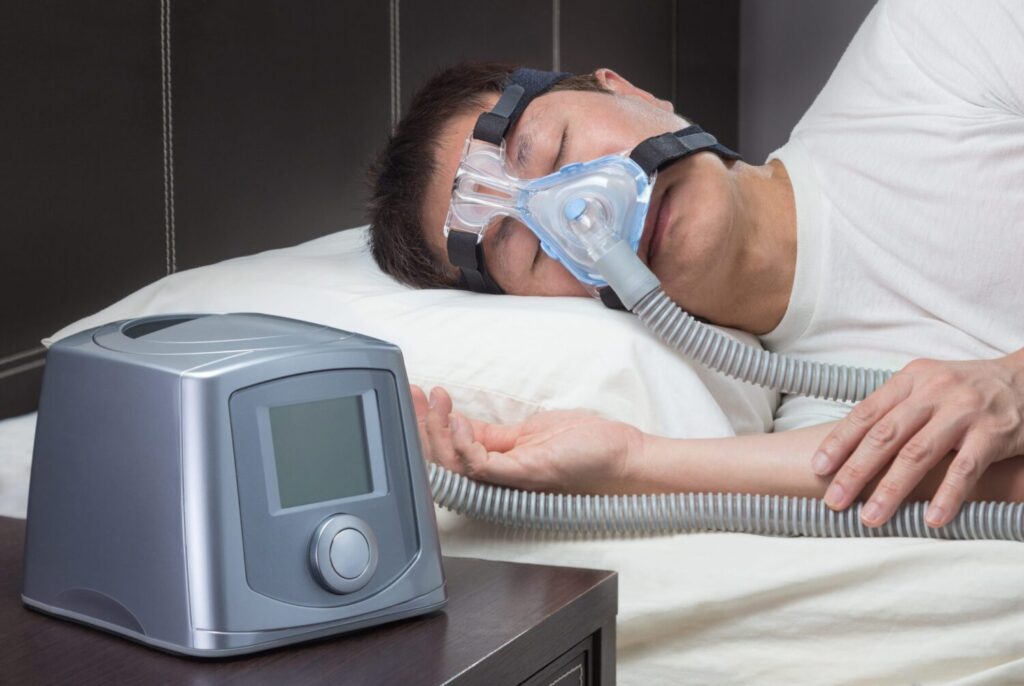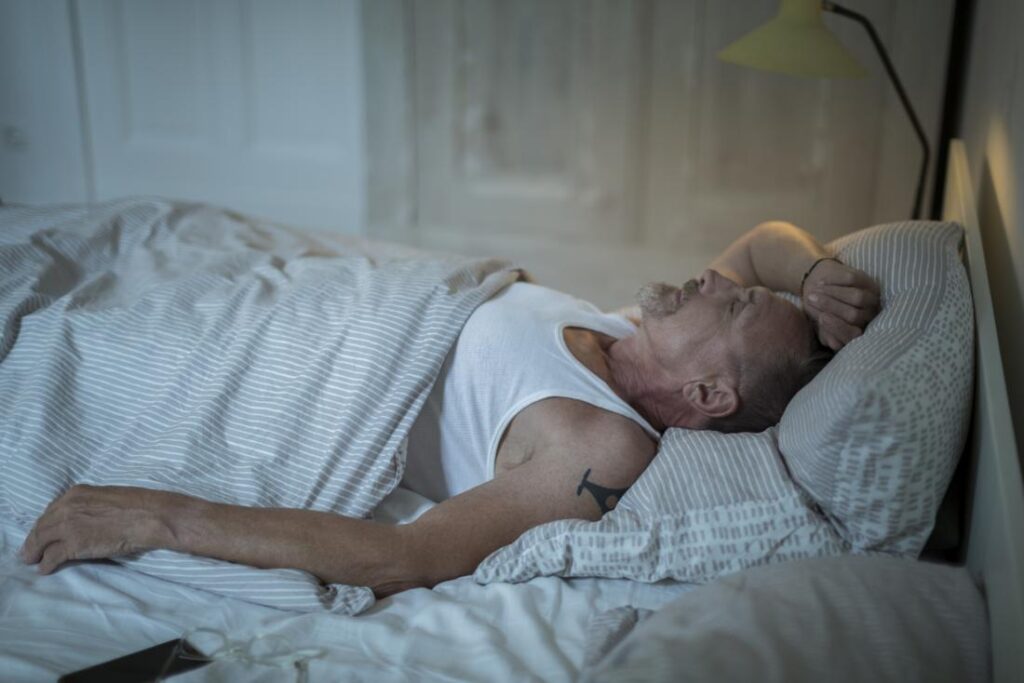The following are some of the many causes of sleep apnea:
Obesity
Adults with this condition often have sleep apnea. The airway becomes much narrower and tighter due to fat deposits in the neck, around the tongue, and on the palate. When you’re laying down when you’re sleeping, it becomes considerably more confined.
It should be noted that not all fat persons have obstructive sleep apnea and that non-obese people might also have the disorder.
Related: Things you should know about sleep apnea treatments
Large tonsils
Because they restrict the upper airway, large tonsils are the most frequent cause of obstructive sleep apnea in children.
Abnormalities of the hormones
Hormones produced by the endocrine system may have an impact on breathing during sleep. Tissue swelling close to the airway may be brought on by endocrine conditions such hypothyroidism (underactive thyroid), polycystic ovarian syndrome (PCOS), and acromegaly (excess growth hormone). They also have a connection to obesity, which results in sleep apnea.

Heart attack
People with heart failure are often diagnosed with sleep apnea. This is due to the fact that the majority of heart failure patients may have fluid accumulation in their necks, which may restrict the upper airway and result in sleep apnea.
Properties of the human body
Airflow may be significantly impacted by a person’s neck, jaw, tonsils, tongue, and other tissues located close to the back of the throat.
Tiny upper airways, a small or receding jaw, a long soft palate, a high tongue position, and a deviated septum are all physical characteristics that might cause sleep apnea.
Inherited syndromes
Sleep apnea may be brought on by genetic abnormalities that modify the skull or face anatomy, particularly those that make the tongue rest farther back in the mouth. These include down syndrome, cleft lip and palate, and congenital central hypoventilation syndrome.
Musculoskeletal disorders
Sleep apnea may also be brought on by conditions that disrupt brain impulses to the muscles of the airway and chest. These illnesses include amyotrophic lateral sclerosis, Lamber-Eaton myasthenic syndrome, and stroke.
Premature birth
Babies that are born early (before to 37 weeks of pregnancy) are far more likely to have respiratory issues as they sleep. But as the brain develops, the danger goes down.

What are the possible causes of sleep apnea?
Obstructive sleep apnea may affect anybody, but some things might make you more likely to have it.
Age and gender
Although sleep apnea may happen at any age, the risk rises with advancing years.
One explanation for this is that as we get older, the amount of fatty tissue in our necks and around our necks grows. Age-related changes in how the brain regulates breathing during sleep also contribute to this.
In younger individuals, males are more likely than women to have sleep apnea, but the disparities disappear as people become older.
Genealogy and genetics
You may be more likely to develop the problem if obstructive sleep apnea runs in your family.
Your cranial facial features and the way your airway is structured may be inherited from your family, which can all contribute to the onset of sleep apnea.
Unhealthy ways of living
You have a higher chance of getting sleep apnea if you smoke, use alcohol, eat poorly, and don’t exercise.
Smoking may lead to inflammation in the upper airways, as well as in the areas of the brain that regulate breathing and sleep.
Unhealthy eating patterns and a sedentary lifestyle raise your chance of obesity, which leads to sleep apnea.
Alcohol consumption may relax the tissue in the throat, making it simpler for the airway to get blocked.
Turning over in bed
The tissues around the airways are more likely to collapse and obstruct while you are sleeping in this posture.
Exactly how is sleep apnea identified?
If you have signs of sleep apnea, you should see a doctor for a proper diagnosis. Before identifying sleep apnea as the cause of your symptoms, your doctor will rule out any other potential causes.
Beginning with a thorough medical history and physical examination, sleep apnea is diagnosed. Your doctor will take into account your signs and symptoms, any family history of sleep apnea, current risk factors, and any adverse effects from undiagnosed or untreated sleep apnea that you may be experiencing.

Additionally, your doctor will do a physical examination to look for any physical signs of sleep apnea, such as a narrowed airway, obesity, big tonsils, or a high neck circumference.
In order to identify any typical sleep apnea difficulties, they may also examine your tongue size and position, jaw structure, and size, as well as your neurological system. They may also examine your lungs and heart.
Your doctor may request blood tests to evaluate specific hormone levels and rule out endocrine problems that might cause sleep apnea in order to rule out other medical causes or illnesses. To rule out PCOS, they could also do a pelvic ultrasound.
Your doctor could do a sleep study if they find that you have signs of sleep apnea.
Only a sleep study can accurately detect whether someone has sleep apnea, and these studies are normally carried out overnight during normal sleeping hours, either at home or at a sleep clinic.
Sleep studies may identify apnea episodes (moments when breathing slows or stops while you sleep), track blood oxygen levels while you sleep, identify low or high levels of breathing-controlling muscle activity, and track heart and brain activity. Additionally, it might reveal the kind of sleep apnea you have.
The most typical sleep tests used to identify sleep apnea are as follows:
Polysomnogram (PSG)
This sleep study is carried out in a sleep lab by a certified technologist. PSG monitors a number of bodily processes while a person sleeps, including blood oxygen levels, eye movement, muscle activity, heart rate, and respiratory effort.
Following the research, the frequency of breathing problems while sleeping is counted, and the severity of sleep apnea is rated.
Sleep apnea test at home
This is often done in the comfort of your own home and is intended for adults. The airflow, heart rate, blood oxygen levels, snoring, and breathing patterns are all measured by the at-home sleep apnea test.
Your doctor could still advise you to have a thorough in-hospital sleep study or to begin sleep apnea therapy based on the findings of your at-home sleep test.
Stopping sleep apnea
The following may assist you in lowering the dangers connected to sleep apnea:
- Maintain a balanced diet and exercise frequently: Your chance of getting sleep apnea may be decreased by maintaining a healthy weight and engaging in regular exercise.
- Try to sleep on your side to lessen the chance that your tongue and soft palate may collapse into your airway, obstructing it and leading to sleep apnea. • Avoid resting on your back.
- Limit alcohol consumption: Avoid sedatives and excessive alcohol consumption since they relax your muscles and block signals from your central nervous system, which might cause you to fall asleep more quickly.
- Give up smoking: Smoking increases your chances for sleep apnea as well as other diseases and health issues including cancer and cardiovascular disease.
